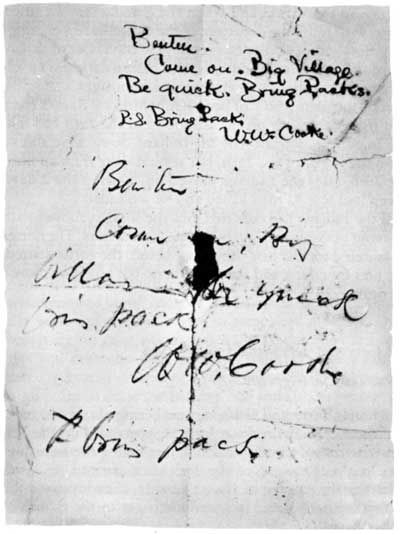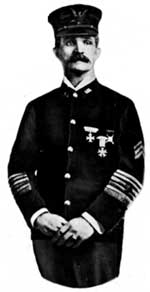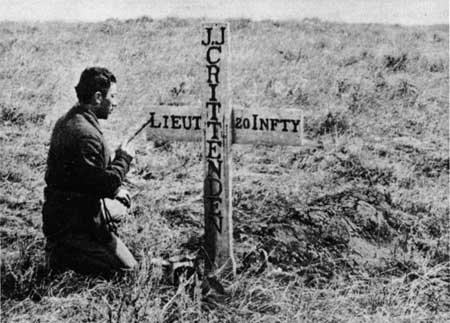|
LITTLE BIGHORN BATTLEFIELD National Monument |
 |

Custer's last message, written by Custer's Adjutant
Lt. W.W. Cooke on a sheet torn from his field dispatch book. At the top
and right of the message is a "translation" written by Captain Benteen.
The original message is in the U. S. Military Academy Library, West Point,
N.Y.
(Reproduced by courtesy of the U. S. Military Academy Library, West Point)
The March of Generals Terry and Gibbon and Their
Arrival at the Battleground
 Trumpeter John Martin who carried Custer's last message to Captain Benteen. (Photograph by D. F. Barry in 1906.) |
The troops of Generals Terry and Gibbon, numbering about 450 men, left the mouth of the Rosebud Creek on June 21, proceeded up the Yellowstone River, and crossed to its south side just below the mouth of the Bighorn River. On the night of the 24th they camped on lower Tullock Creek. The 25th, the day of Custer's battle, they traversed the arid hills along the Bighorn River in an effort to get to the mouth of the Little Bighorn River.
On Monday the 26th, near the mouth of the Little Bighorn River, these troops had sign talk with three Crow Indians who had been scouts with Custer. The Indians told them all the white men had been killed. None of the men fully believed this story. The entire command marched up the Little Bighorn Valley, continually noting Indians farther up the valley and on the bluffs to the right, some riding singly and others in groups. That evening camp was made near the present site of Crow Agency, Mont.
On the morning of the 27th no Indians were seen by the troops and, following breakfast, the march southward began. Lieutenant Bradley, with a detail, was sent on special scout duty to the east side of the river. After the main column of troops had marched south up the valley about 3 miles, an officer saw men and animals moving on a hill 3 miles to the east across the valley. An officer, with a few men, was detailed to get closer to this group to identify them. They proved to be a detachment which had been sent by Reno. The story was told of the disappearance of Custer and his battalion.
While this conference was in progress, Lieutenant Bradley and his scouting party returned. He brought the first official news of the tragic loss. On July 27, 1876, in the Helena Weekly Herald, Bradley made the following statement of what he had found:
"Of the 206 bodies buried on the field, there were very few that I did not see, and beyond scalping, in possibly a majority of cases, there was little mutilation. Many of the bodies were not even scalped, and in the comparatively few cases of disfiguration it appeared to me rather the result of a blow than of a knife . . ."
Immediate action was taken to care properly for the wounded men in Reno's command. They were transferred before the day ended from the Reno defense area on the hills to the valley where Generals Terry and Gibbon had set up camp, and the men began work making litters on which to transport them.

Grave of Lt. John J. Crittenden, Twentieth United States
Infantry. He was attached to the Seventh Cavalry for duty and killed
with Custer's troops. Photograph taken in 1877.
(Courtesy of the
National Archives.)
On the 27th, a group under the supervision of Captain Benteen was sent to Custer's Battlefield to make a survey of the field. Early the next day the Seventh Cavalry proceeded to the battlefield to locate, count, and bury the bodies of their comrades. Four officers and 14 enlisted men were found to be missing, but none was found alive. Accounts vary as to what percent of the bodies were scalped or mutilated. Much of the clothing and personal belongings was missing. It is known that General Custer's body, though stripped of clothing, was neither scalped nor mutilated. He had been struck twice by bullets, either one of which could have been fatal. The burials were made in shallow graves and properly marked wherever identification was possible.
Previous to the arrival of the soldiers, the Indians had carried away and cared for most of their own dead. The exact place of their burials is not known. The loss of the Indians has never been satisfactorily deter mined. Published figures vary from 30 to 300.

|
|
Last Modified: Sat, Sep 28 2002 10:00:00 pm PDT |


